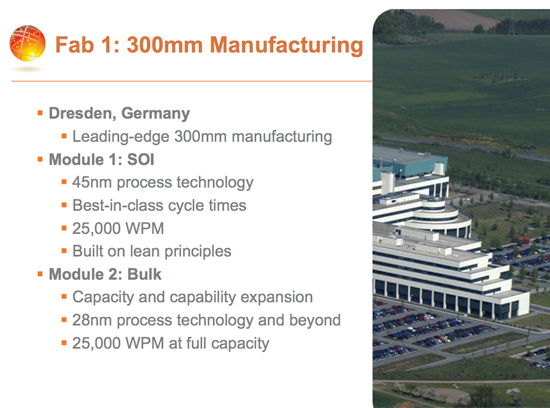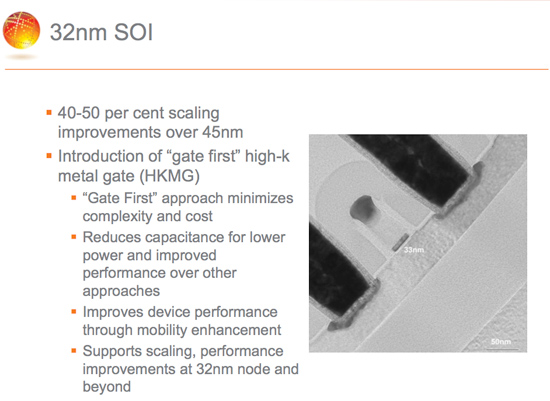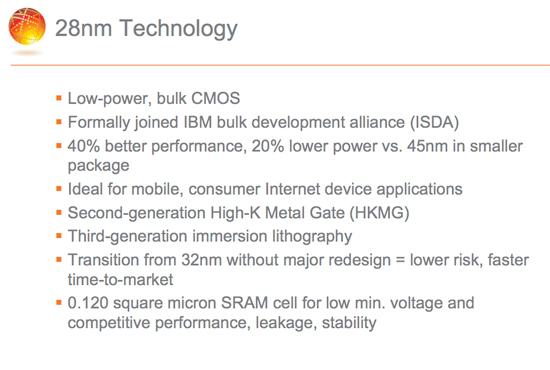Globalfoundries Starts on 22nm Fab & Announces First non-AMD Customer
by Anand Lal Shimpi on July 29, 2009 4:01 AM EST- Posted in
- CPUs
The Roadmap
There’s clearly a need for a company like Globalfoundries, even if just to keep TSMC on its toes (hooray competition). But then reality sets in, Global isn’t much of a TSMC competitor yet - it still only has one fab producing 45nm silicon and only SOI at this point.
Here’s what Globalfoundries plans on doing with its existing fabs:

In the second half of 2010 Global will move one of its Dresden fabs to 32nm SOI production for AMD’s CPUs. I’m not expecting anything else to be made on this process other than AMD CPUs at this point.
We’ll see a “low power” 40/45nm process come out of Dresden near the end of 2010 as well. This will actually be for GF’s first non-AMD customer: STMicro.
The real transition happens in 2011, when Global upgrades its older Dresden fab to support 28nm bulk silicon production. Globalfoundries views 28nm as the transition point for many potential customers. It’s not that there’s anything magical about 28nm, but many companies currently have designs for TSMC’s 40nm process and it makes little sense to redo them for manufacturing at Globalfoundries. At 28nm they can simply design for Globalfoundries’ process from the start.

The fabs formerly known as Fab 30 and 36
Note that this 28nm process is a “half-node” (between 32nm and 22nm) and where I’m expecting to see ATI (and NVIDIA) GPUs made at Globalfoundries. The current 40nm products are being made at TSMC but it’s possible that we’ll see the next-generation pitched to GF. The first hybrid CPU/GPU from AMD will be built on GF’s 22nm SOI process in 2012.
Bulk vs. SOI
Back in 2001 AMD started to move to SOI (Silicon on Insulator) for its CPU manufacturing. The benefits of SOI were lower power and faster switching rates, although it came at a higher manufacturing cost. AMD will continue to use SOI for its high performance CPUs because their price can justify the additional manufacturing cost. More price sensitive markets don’t need the performance benefits of SOI and would rather not deal with the price penalties of it either; for those companies Globalfoundries needs to provide a bulk silicon process and in 2010, they will get just that.

Enabling SOI as well as bulk silicon manufacturing isn’t all that difficult but it does require some work. The first bulk process in Dresden will be a 40nm low power process out of Fab 1 Module 1. The first customer? Not AMD, but rather STMicro. These are the folks who used to make the old Kyro graphics cards, but obviously they’ll be making low power SoCs here instead.
In 2011 Global will offer a 28nm LP bulk process as well as a 28nm general purpose bulk process. The latter will be used for GPUs and other non-ultra-low-power devices.

Again, all of these plans involve AMD’s old fabs in Dresden, Germany (formerly Fab 36 and Fab 30, now Fab 1 Modules 1 and 2). Once 2012 rolls around, there will be a new player in town.










50 Comments
View All Comments
aguilpa1 - Wednesday, July 29, 2009 - link
MTvol7ron - Wednesday, July 29, 2009 - link
This is good and bad.It's good because the costs could be driven down, but as said it seems like Intel will be on 22nm-12nm before AMD gets a deep breath of the 32nm market. Not to mention, when you branch out into a new factory and new process like that, you're likely to run into other problems.
Time will tell. Maybe this will give AMD some time to really think about its chip architecture.
TA152H - Wednesday, July 29, 2009 - link
This article is full of nonsense.AMD could easily own fabs without owning the PC market. IBM does. Does IBM ship as many processors as Intel? Hmmmm, doubtful.
It's kind of funny how AMD couldn't afford fabs when their processors suck, but could when they the better processor.
Fabs ARE expensive. So is not owning one. Buying ATI gave them plenty of uses for their fabs, except they never built ATI stuff on them. Especially with the chipsets, they could have used their older equipment to keep building them.
Let's face it, AMD ran into trouble because they can't make a decent processor. They make a large processor that can't perform. It's the same size as the i7, but it surely can't sell like one, so they have to sell it really cheap so it makes sense to buyers.
Real men have fabs. That's from Jerry Sanders, and he created AMD, only to have Hector Ruiz castrate it, and destroy it. They Phenom is just a bad design compared to its competition, and they have no answer for the Atom, which is gaining acceptance. That's the problem. The slow market share gains AMD was making ended when they ran into a buzzsaw called the Conroe, and so did their profits. Sure, it's the fabs. Uh huh. Funny, though, how Conroe made them a lot more expensive, isn't it?
Selling their fabs was like cutting their arm off, and thinking they would win in a heavyweight boxing match. Sure, they got their weight down, and will have a little more stamina, but they are a one-handed fighter now. It's fine against half-rate companies like Nvidia, that also have no fabs, but against Intel, it just won't cut it.
Inferior design and no fabs :( . Little wonder why they are losing money? The worst part is, it just looks worse for them. Intel's roadmap is full of interesting new products. AMD's? Good grief. Does Jerry Sanders have any kids???? He could pull magic out of hat. These ass-clowns running AMD are just running it into the ground. Thank goodness they have ATI though. ATI still makes great products, and was a very good move for them, despite the cost. I wish AMD would just stop trying to compete with Intel on performance - let's face it, they can't. They're not smart enough, and they don't even own fabs. If they could make a chip that's smaller, and less expensive to make, and slower, instead of one that's the same size and slower, they'd have a market. If they could make something 60% of the size, with 75% of the performance, they'd have something. Or something close. Something between the Atom and i7. But, nope, they make something 100% of the size, with 65% of the performance. Give them credit, that's hard to do. I don't know anyone else who would reward such incompetence with jobs. Something has to change there. They can't compete with Intel in performance, but they might be able to make something smaller that offers good enough performance. It's a huge market. Selling an expensive to make chip into it isn't the right approach, but it's all they have with their awful design. ATI executed perfectly with their designs, by not trying to make it huge and super-fast. AMD should borrow some folks from there.
brybir - Wednesday, July 29, 2009 - link
I fail to see why this article is full of nonsense as you say.The point of the article is that building fabrication facilities is a very high cost capital element for a company that does not have the scale to adequately absorb the costs.
For example, AMD had two fabs. Say they get close to maxing out those fabs producing the Athlong X2 XXXX+ stuff. Their decision is "do we invest in a new fab to the tune of $4bn dollars or not". Now, say they commit the money to build it, $4bn, and then they produce something called the "Phenom" which ends up being a gigantic turd. Suddenly they are hemoraging a lot of cash. That $4bn they started to spend on a fab is no longer needed as they lose market share. This only can happen a few times for a company the size of AMD before it is bankrupt.
The article basically implies that the company needs to be the size of Intel, IBM, Sony etc who can infact take the risk to build a new fab. If Intel, the current majority owner of the CPU market, builds a fab and in the next generation after i7 and i5 they produce another P4 esk piece of crap, they can absorb the extra cost of the foundry they started to build. Its about size and scale. Intel also can draw its fab's out over longer lifetimes making chipsets and flash, whereas AMD does not make much of that stuff these days.
Short story is that AMD is not in the position to build fabs and capitalize it on the way a larger company that makes a diverse set of products can.
As to ATI...the designs are build on a process years before we see them, its not like they sit down 6 months before product launch and start designing. Its a constant cycle with the planning done for years in advance. Could AMD have produced ATI chips in its fabs? Yes, as they are going to start doing it on GF in 2010+. But, AMD is in the same position, what happens if "bulldozer" ends up being a rockstar and ATI produces a nVidia killer GPU and everything is being made on two fabs in Germany. Its possible there will be product shortages and how would that look...AMD finally makes a good competitive product and its cant make enough....certainly has never happened in the past....
As to your last rant about price/performance....I dont even know what to say. You say things like "something between the Atom and the i7"...thats not even a statement. It means nothing. They execute designs years ahead (notice the trend here on the planning thing) and something it does not go according to plan. Remember when AMD had better CPU designs for a good while during the P4 years, when Intel made huge CPU's with extremely deep pipelines that were also as large or larger and often had to be sold at discounts. There was that bit about Intel abusing its monopoly status and such too but we can ignore that for now. The point is, things are planned and sometimes they go accordingly and sometimes they dont. Your ranting statement could change AMD to Intel and it would be true a few years ago.
Today its AMD that is failing to execute as well as their competition. But to say that they are not as smart or that no one should give them jobs etc....give me a break. What do you want AMD to do, just stop producing their current CPU's and wait a yaer or so until their next generation is ready to go? But wait, im sure they can design one of the most complicated mircoprocessors in the world in like 6 weeks or something right?
jconan - Tuesday, August 4, 2009 - link
but IBM is also a foundry like GF, though not as large as TSMC they also manufacture chips for other companies ie Nintendo, AMD, Sony, and etc...TA152H - Thursday, July 30, 2009 - link
I'll repeat my other statement. IBM is making money with their fabs, because they sell decent processors that they can get margins on. AMD isn't. This article has it all wrong. They could have fabs, if they sold processors with a decent margin. That's the root cause.I'm not saying AMD shouldn't second source some of their production, which you're implying. I'm simply saying they need their own fabs. There's a synergy between manufacturing and design, and now they don't have it. Intel does though.
I'm not suggesting they build another fab, yet. I'm suggesting that in order to compete with Intel on anything near equal terms, you need your own fabs. As Winston Churchill said, wars are not won on retreats. Losing your fabs is a HUGE retreat, and now they have a big competitive disadvantage compared to Intel.
Intel's Pentium 4 showed just how smart they were, and how stupid. It was an extremely advanced design, far more advanced than anything available at that time, and also a bad performing one. AMD is still making a K7 with some changes now, and not enough of them.
The remarks about the Atom and i7 are insane. I'm not suggesting AMD should have known about the Atom, or they are smart enough to design something like it. Clearly they're not. But, why are they still using a huge x87? They got rid of x87 instructions in x86-64 back with the Athlon 64. Why are they still supporting 3D Now! SSE came out around 2000? The Conroe came out in 2006. It's 2009. Why are they so far from being competitive?
They should ditch their current designers, and hire some from IBM. Not that it would be easy, but if you offered a guy third in line to be your lead designer, you'd get a lot of guys with that type of promotion. Two companies still know how to make processors, IBM and Intel. AMD can't. They need to get some designers from IBM, or another company that doesn't make failure after failure, and stop rewarding the people that are in charge. They haven't advanced the design NEARLY enough since 2000. Something has to change, and the constant delays to Bulldozer aren't the type of change that's needed. Maybe they can get some SPARC designers. I don't know how good they are, but they at least can introduce some new ideas. Besides, how can they be worse?
I still think AMD is best served by their ATI approach. A size that makes sense, and don't try to be the fastest. That's been AMD's approach for almost forever, and it can work. From 2000-2006 they competed for absolute performance, because Intel made a pig, but that's not the norm, and AMD got sucked into it a slugfest they can't win. It's like watching an old fight with guys fighting Marciano. They think they can outpunch him, and slug for a while because they aren't entirely unsuccessful, but then get worn out while he doesn't. In the end, they end up flat on their back wondering why they tried such a strategy. It's tempting, but ultimately disastrous. AMD's flat on their back, with their feet in the air, losing massive amounts of money any quarter. Selling fabs won't change it - designing a good processor might.
bh192012 - Wednesday, July 29, 2009 - link
"Short story is that AMD is not in the position to build fabs and capitalize it on the way a larger company that makes a diverse set of products can. "Then the other route they could have tried would be to become a larger company and make more products. Like their own GFX chips, SSD hard drives, stmicro chips etc. Bascially everything described in the article could have been done w/o breaking off the fab, except maybe hoping to make Nvidia graphics chips. The biggest difference would be the 6 billion in cash, which is probably the main real reason they did what they did?
zebrax2 - Thursday, July 30, 2009 - link
If only its as easy as you say it is. Going to other markets needs money and money is what they don't have. Plus add to that the time needed for R&D of the said new products. They would have already bled to death before they were even able to release it.B3an - Wednesday, July 29, 2009 - link
I dont know why you have bothered write such a long reply to such an amazingly stupid post by a moron that obviously knows absolutely nothing.I particularly like the part:
"AMD could easily own fabs without owning the PC market. IBM does. Does IBM ship as many processors as Intel? Hmmmm, doubtful."
That made me LOL. As if AMD even have 1/4 the money IBM have to build and maintain fabs.
JonnyDough - Monday, August 3, 2009 - link
Yeah, that's what I was thinking. I don't think this moron realizes who/what IBM is...they're a giant.